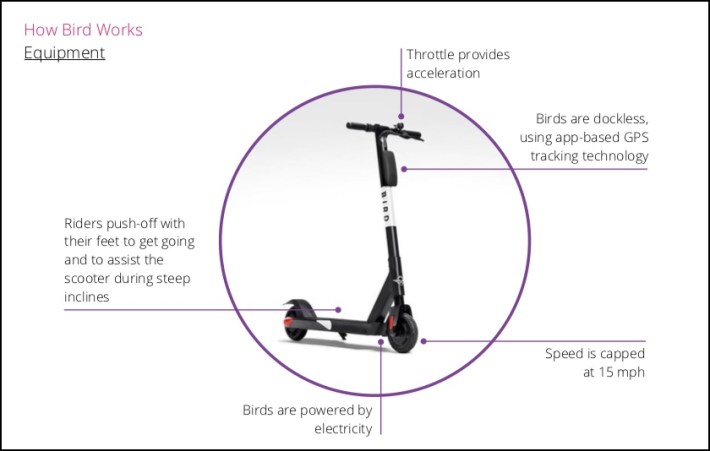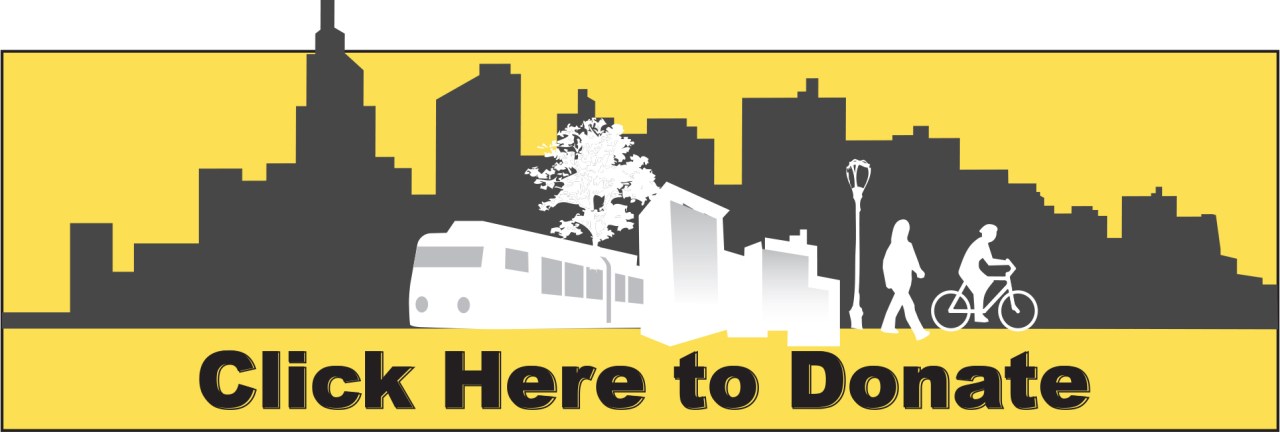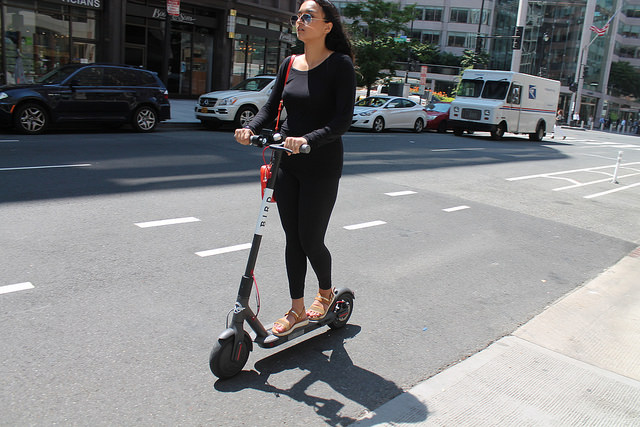In just over a year, e-scooters have gone from a freakishly rare novelty to almost ubiquitous in American cities.
Billions of venture capital goes a long way, fast. Bird alone claims to be operating in more than 100 cities.
There are as many as 17,000 e-scooters on the streets of Los Angeles, the Wall Street Journal reports, available to adults for as little as $1.15 per ride. And there are 13,000 in San Diego and almost as many in Austin.
We're just now beginning to understand the impacts.
The CDC is gearing up to do the first authoritative study of e-scooter safety. The study will examine 68 e-scooter injuries that took place over a two-month period in Austin. Over that time, there were 37 EMS calls or about one every other day, the report says. There are almost 12,000 e-scooters approved for operation on Austin's streets and they took about 235,000 trips in October, according to city data.
Meanwhile, in recent months there has a been rising alarm about injuries. Doctors in cities such as Nashville and St. Louis have discussed worrying levels of injuries, saying scooter crash victims are flooding their emergency rooms.
Apparently, mayors have concerned as well.
“Every mayor who’s got 'em comes up to me and says, ‘Don’t take 'em," Seattle Mayor Jenny Durkan said recently. "And the reason is ... every city that has scooters has significant traumatic injuries.”
San Jose Mayor Sam Liccardo last week threatened to ban them unless the companies could use a technology like geofencing to keep e-scooters off the sidewalks.
“If there is not significant improvement in safety of e-scooters, ultimately bans are coming,” he told the San Jose Mercury News. “There are serious injuries happening out there.”
The scooter companies — especially Bird — have deflected such concerns by pointing to the far more catastrophic danger of cars. Their defenses mirror, to an uncanny degree, urbanist messages. In response to a class-action suit by injured scooter users, Bird said:
“Class action attorneys with a real interest in improving transportation safety should be focused on reducing the 40,000 deaths caused by cars every year in the U.S."
So how are e-scooters performing on safety? It's not an easy question to answer, in part because the scooter companies have been pretty secretive with their data, although that's beginning to change. And it's also difficult to say because scooters are such a new technology and, as they become integrated into urban landscapes, may experience lower and lower injury rates as cities redesign streets — similar to how cities such as New York reduced cycling deaths even as the numbers of bike riders increased.
Fatalities
So far there have been two — or three — e-scooter deaths it depends on how you count them.
In D.C. in September, a 20-year-old man was killed when he was struck by an SUV driver while riding a Lime scooter. In Dallas the same month, a 24-year-old man died in what appears to have been a solo fall from a Lime scooter.
Finally, in August, a 21-year-old woman was killed in downtown Cleveland when she was struck by a driver who, cops say, high on heroin. She was riding a scooter-hybrid with a seat she had rented from a storefront rental business — not one of the mass marketed dockless varieties that have taken over cities.
It's hard to assess two or three deaths out of 40- to 60-million rides on a completely new vehicle with which very few people have become comfortable. By comparison, cars kill about one person per 80 million vehicle miles, a number that has been declining over the long term. But given how many miles Americans drive, cars kill tens of thousands of people every year. Scooter trips are typically a mile.
To put those numbers in perspective, a 2015 study by Ralph Buehler and John Pucher estimated that 2.25 cyclists die on their own bikes, and 5 bike-share riders die, for every 100 million miles in London and Paris.
The London and Paris numbers "might be more comparable to the scooter data, since they are for cities rather than whole countries, and urban areas tend to be somewhat safer than rural areas," said Kay Tscheke, a public health researcher at the University of British Columbia.
But so far, anyway, the record for e-scooters does seem to be a bit worse than bike share in the U.S. Last year, the National Association of City Transportation Officials wrote that there have been 123 million bike share trips through the end of 2017, going back almost a decade. The estimated length of those trips is between 1.5 and 3 miles.
There have only been two bike share deaths in the U.S. in the whole history of modern bike share. That means, using an average trip length of 1.5 miles, a conservative estimate, that's a death rate of one per 92 million miles for U.S. bike share, even excluding all the miles ridden this year.
Injuries
Evaluating injuries is more difficult. Anecdotal data are concerning, however, if you take them at face value.
Peter Holley at the Washington Post wrote in September that scooter riders were "pouring into emergency rooms" and that their injuries "looked like car wrecks," including "broken noses, wrists and shoulders, facial lacerations and fractures, as well as the kind of blunt head trauma that can leave brains permanently damaged." The story cited dangers in many cities.
In Santa Monica — the "e-scooter and e-bike capital of the world," according to Curbed — 18 serious injuries were reported by the Fire Department over just a two-week period in July.
At St. Louis's Washington University, professors recently sounded the alarm over the high number of injured scooter riders arriving in the affiliated hospital's emergency room. They reported six to seven ER visits per week over a two-month period. It wasn't just bumps and bruises. Of those injuries, six required surgery and 12 were admitted to that one hospital through the emergency room.
"The costs for our city to allowing these e-scooters has probably been underestimated," the professors concluded.
Doctors in Nashville offered perhaps the most concerning anecdotal evidence yet about the safety of e-scooters. Vanderbilt Medical Center Trauma ICU director Oscar Guillamondegui told Nashville Public Radio that they were getting one injury per month that was "life changing," meaning the person suffered what was likely permanent brain damage. For perspective, the city's current policies allow up to 3,000 e-scooters in circulation.
The vehicles themselves

Some people question whether the design of the e-scooters used by Lime and Bird has inherent safety drawbacks.
"Scooters have small wheels," Arizona State University Professor David King told Streetsblog. "That means they need really really flat smooth pavement. We don’t maintain that for anybody."
The Riverfront Times, an alt-weekly in St. Louis, tested the devices in July, shortly after they arrived in the city. A mostly lighthearted article by Daniel Hill called them "moderately terrifying":
Over the course of two days, I had to bail twice, went flying over the handlebars once (didn't see that hole in the ground) and straight laid it down and slid across the pavement once (avoid multi-tasking with your hands while riding, even if you're thirsty). Be prepared for road rash.
James McPherson, an attorney with experience litigating accident claims and who writes at SafeSelfDrive.org, raised additional concerns about the design of e-scooters, including high center of gravity, a narrow side profile.
A seat might improve safety, making scooters more like low riding bikes without pedals than upright crash machines. A seated rider lowers the center of gravity and widens the profile so he or she is more visible from the side.
We asked a Bird spokesperson how the vehicles handle on potholes. On background, that person told Streetsblog it was riders' responsibility to avoid potholes. That means riders have to be scanning the environment both for cars and the street for potholes at the same time.
We asked Bird other questions: Did the company make any attempt to design the vehicles for maximum safety? Did the company consider the bike infrastructure in a city before setting up shop? On the record, the company offered only boilerplate about how riders are encouraged to wear helmets and how Bird encourages cities to add bike infrastructure.
Cost, not safety, seems to be an important part of the business model.
According to the Wall Street Journal, e-scooters cost about $500 each. The profitability of the companies is directly related to the price per vehicle versus how many times it is rented before it needs to be replaced. Vandalism and wear and tear are forcing the companies to replace them every two months on average. And investment prospects have been softening in part because of the limited shelf-life of the vehicles, the Journal reported.
Both Lime and Bird are valued at more than $2 billion.
How big are the environmental benefits?
Both Lime and Bird are hoping cities focus on the potential environmental benefits of e-scooters over cars.
“We don’t have a year to wait," David Estrada, Bird’s chief legal officer and head of public policy, recently told Curbed. “Are cities going to choose to help solve the climate crisis and get people out of cars?”
It's impressive that e-scooters have amassed between 40 to 60 million trips for a form of transportation that barely existed a year ago. But how many of those are displaced driving trips?
We don't really know. An often-cited, though unscientific, survey in Portland found the car trip replacement level was pretty high — more than a third for locals and even higher (51 percent!) for tourists.
The survey's limited response rate makes it digestible only with more than a few grains of salt, but it wouldn't be surprising if e-scooters were replacing car trips at close to that range. Of course, even with healthy car-replacement levels, a large number of trips will replace walking, biking or transit as well. In those cases, they may actually increase the environmental impacts of some short trips, especially since e-scooters have such a short shelf life.
Safer streets
Scooter companies say safety will improve as scooter use becomes more widespread, creating pressure on city officials to redesign streets and add bike lanes.
Anecdotally, it seems to be true. Kansas City recently tested out a combined bike and scooter lane. And Bird has begun providing money for cities to add bike infrastructure.
Perhaps, as Bird asserts, e-scooters will eventually displace enough car trips to have a measurable impact on traffic safety.
Researchers Peter and Joel Jacobsen — whose research helped establish the "safety in numbers" effect for biking — say they expect scooter injuries to decline as they become more common, as both drivers will become more aware of them and they help produce changes in the environment. The Jacobsens said, while there wasn't very much data, they would expect the safety outcomes of e-scooters to be similar to biking and walking.
Our very rough fatalities analysis supports that idea. But if the injuries show something different, it will be interesting to see how that impacts the industry and the regulatory environment. It's also possible it will help alleviate worries and lead to wider adoption.







